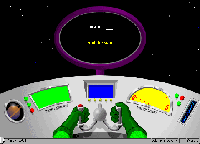





|
Review of
Math Blaster 1: In Search of Spot
 Published by: Knowledge Adventure
Published by: Knowledge Adventure
Year: 1994
Suggested Age Range: 6-12
Platform Information: Mac or PC
Reviewer: Megan Murray
Image © Knowledge Adventure. Used with permission.
Is the Game Mathematical?
Math Blaster 1: In Search of Spot focuses on number sense and computation. Of the four activity screens in Math Blaster, two are basic drill and practice of computational "facts." In both areas, computation problems (in one of eight areas such as multiplication or estimation) appear and the player must either type in the answer, or direct an alien across the screen to the correctly labeled part of the spaceship. With the addition of non-mathematical actions such as trash shooting and diamond chasing, one gets the sense that kids are being "fooled" into having fun doing what they would prefer not to do if it was a paper and pencil task. In this sense, Math Blaster offers what we consider "sugar-coated math," and seems to reinforce the idea that mathematics, on its own, is boring.
The other two activities in Math Blaster offer more than drill and practice. In one you must arrange numbers into correct equations, and in another you must direct an alien through a cave-like maze. As the alien flies through the cave, the ledges, the falling raindrops, and the alien itself are labeled with numbers. When the alien hits a drop, the number on its chest changes. In order to fly between two ledges, the number on its chest must be between the numbers on the ledges. The mathematics of these areas is quite similar to the other two: practicing computation skills. However, in these two areas, the presentation of the mathematics is different. They involve more puzzlement and reasoning.
Help is offered in several ways. For example, in the first activity, the answer space provides as many lines as numbers that are needed for a correct answer (for example, "12 x 10 = _ _ _"). Incorrect answers prompt you to try again, and then offer a help screen (also available from a pull down menu), aiding the player in one way of solving the problem. For example, for a simple addition problem, the game will provide the player with a number line and prompt them to count up on the number line. If the player clicks "Show Me" it will actually show them a way to count up on the number line. A player who has a different solution process (or does not understand the one offered), may not benefit from the help that is proffered.
Is the Game Equitable?
Three of the four activities in Math Blaster are characterized by video game-like activities -- shooting trash, avoiding trash, getting diamonds (bonus points), or using hand-eye coordination to maneuver an alien through caves or into a spaceship. In fact, the box even advertises "arcade-style" game play, and the setting brings to mind typical video game contexts (space, aliens, saving the galaxy and a kidnapped friend). It seems that Math Blaster is trying to use the huge popularity of video games to market and sell their product. It should be noted that the huge majority of that market is made up of boys. Also, players who would benefit from cooperative playing and who might need time to better think through problems may be discouraged by the reliance on hand-eye coordination and the focus on speed that many children attribute to this game.
Is the Game a Good Game?
One issue with Math Blaster is how often children will come back to it. In the two drill and practice activities, you can explore a different content area (multiplication instead of addition) or increase the level of difficulty (to deal with somewhat larger numbers). But the basic format remains the same ("4+ 5=_" or "4x5=_ _"). There's not much to encourage persistence, particularly since there's not that much to puzzle out -- you either know it or you don't. Although some children did have a hard time deciphering the interface and mechanics of the cave puzzle, the equation maker and the caves may engage kids over longer periods of time.
In one study conducted over five weeks, children chose freely (after a five minute introduction to each game) from eight available games. Math Blaster was chosen three times out of a total of 93 (eighth out of eight games). Not exactly a ringing endorsement from this group of eight to twelve year olds.

Back to the top of the page
|



